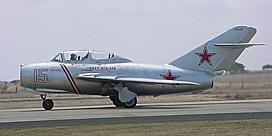Mikoyan-Gurevich MiG-15
|
|
The Mikoyan-Gurevich MiG-15 (NATO reporting name "Fagot") was a jet fighter developed for the USSR.
History
When Soviet forces overran Berlin in 1945 they were able to confiscate plans for the Focke-Wulf Ta 183 jet fighter. After the war they continued the project under the bureau designation I-310, which first flew in 1947. Previous Soviet designs like the MiG-9 had been hampered by the poor quality of available engines. They had acquired wartime German jet engines, which had been none too reliable to begin with, and the Soviets had made little headway with them. However in 1946, before the Cold War had really begun, the British government allowed the Soviets to acquire a manufacturing license for the Rolls-Royce Nene centrifugal flow turbojet engine, as the Klimov RD-45. Initial problems of metallurgy forced the Soviet engineers to develop a better copy, which entered production as the Klimov VK-1.
The I-310 was a clean, swept wing fighter with wings and tail swept at a 35° angle. Although it possessed a number of dangerous handling eccentricities (some of which were never really resolved), including pitch-up at transsonic speeds, it had exceptional performance, with a top speed of over 650 mph (1,040 km/h). Designated MiG-15, the first production example flew on 31 December 1948. It received the NATO reporting name "Fagot", entering Soviet air force service in 1949. An improved variant, the MiG-15bis, entered service in early 1950, with a number of changes intended to mitigate the aircraft's handling flaws.
The MiG-15 was originally intended to intercept American bombers like the B-29. To that end it featured heavy cannon armament: two 23 mm cannon with 80 rounds per gun and a single massive 37 mm cannon with 40 rounds. These weapons provided tremendous punch, but their limited rate of fire made it more difficult to score hits against fast jet fighters. The 23 mm and 37 mm weapons also had radically different ballistic characteristics, and some United Nations pilots during the Korean War had the unnerving experience of having 23 mm shells pass over them while the 37 mm shells flew under them. An advantage of this armament was that the MiG-15bis and later versions carried the guns in a detachable under-nose pack which would be lowered with a crank and reloaded in as little as 15 minutes, enabling rapid turnaround times.
A variety of MiG-15 variants were built, but the most common was the MiG-15UTI (NATO 'Midget') two-seat trainer. Because Mikoyan-Gurevich never mass-produced trainer versions of the later MiG-17 or MiG-19, the 'Midget' remained the primary Warsaw Pact jet trainer well into the 1970s.
The MiG-15 was widely exported, with the People's Republic of China receiving MiG-15bis models in 1950. Chinese MiG-15s took part in the first jet-versus-jet dogfights after the Communist invasion of South Korea, and proved superior to the UN air forces' F-80 and Gloster Meteors. Even the F-86 Sabre, introduced in December 1950, was inferior to the MiG-15 in many respects, although superior tactics and pilot training often allowed UN pilots to get the upper hand. Desperate to get hold of an intact MiG for testing, the United States offered $100,000 and asylum to any pilot who would defect with their aircraft. Eventually a North Korean pilot, who claimed to be unaware of the proferred reward, landed at Kimpo Air Base in September 1953, allowing the first detailed evaluation of the aircraft. This aircraft is now on display at the National Museum of the United States Air Force near Dayton, Ohio.
It was a MiG-15 that in July 1952 shot down a Swedish DC-3 over the Baltic Sea at the beginning of the Catalina affair.
The USSR built around 8,000 MiG-15s in all variants. It was also built under license in Czechoslovakia (as the A-102 and S-102) and Poland (Lim-1 and Lim-2).
China did not produce the type locally, but operated Soviet-built aircraft as the J-2 or JJ-2 (MiG-15UTI).
Yuri Gagarin died in a training flight in a MiG-15.
Specifications
MiG-15bis (1950)
- Length: 10.85 m
- Wing span: 10.29 m
- Height: 3.65 m
- Weight: (empty) 3,690 kg (maximum) 6050 kg
- Engine: Klimov VK-1 turbojet producing around 27.5 kN thrust
- Speed: (maximum, sea level) 1,070 km/h (cruising) 840 km/h
- Range: 950 km
- Ceiling: 15,500 m
- Armament: Two Nudelman-Suranov NS-23 23 mm cannon (later two NR-23) and one NL-37 37 mm cannon, plus rockets or bombs on underwing hardpoints
| Related content | |
|---|---|
| Related Development | |
| Similar Aircraft | |
| Designation Series | |
| Related Lists | List of military aircraft of the Soviet Union and the CIS - List of fighter aircraft |
|
Lists of Aircraft | Aircraft manufacturers | Aircraft engines | Aircraft engine manufacturers Airports | Airlines | Air forces | Aircraft weapons | Missiles | Timeline of aviation |
Template:Commonsde:Mikojan-Gurewitsch MiG-15 nl:Mikoyan-Gurevich MiG-15 pl:MiG-15 sv:MiG-15

